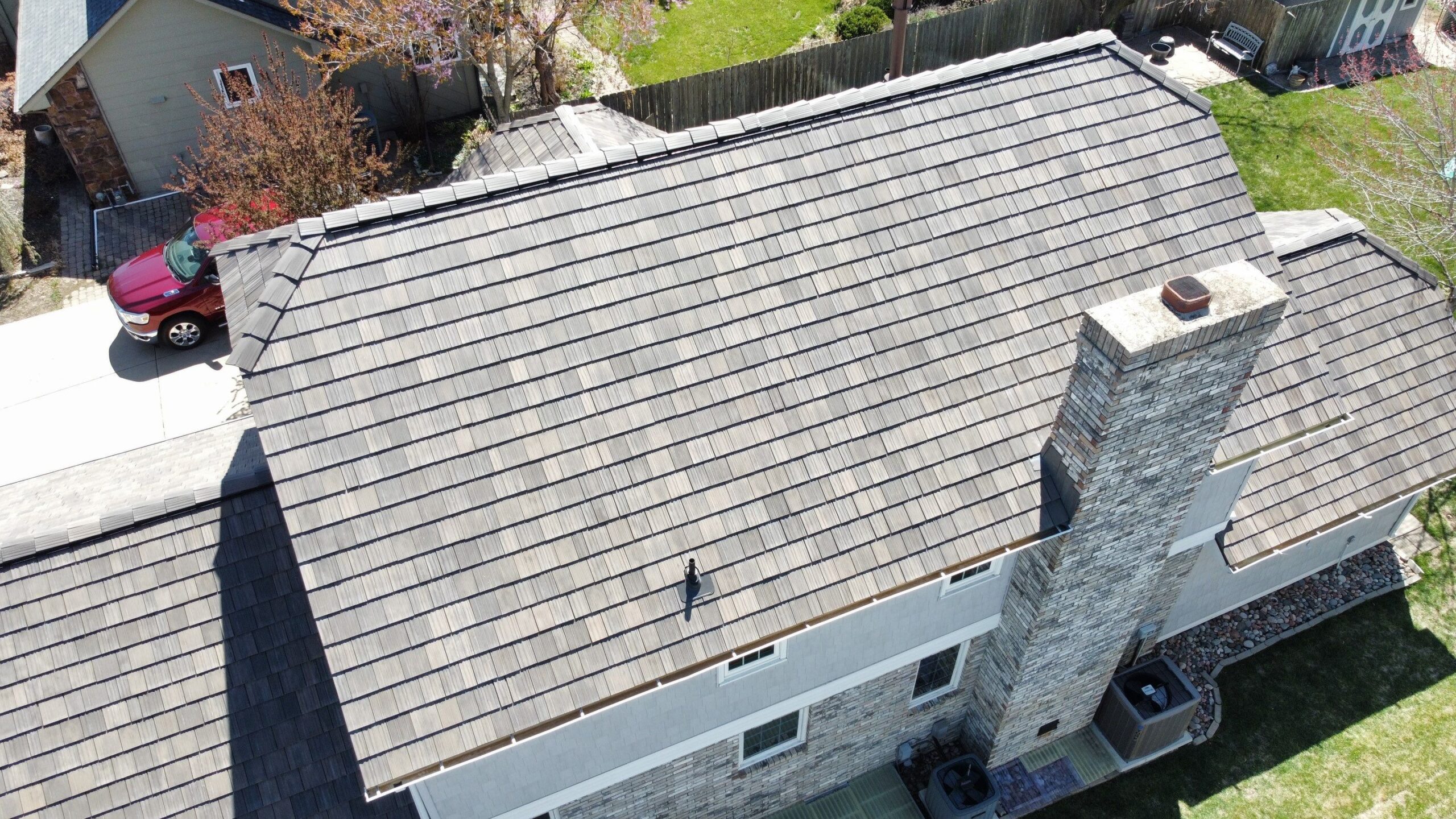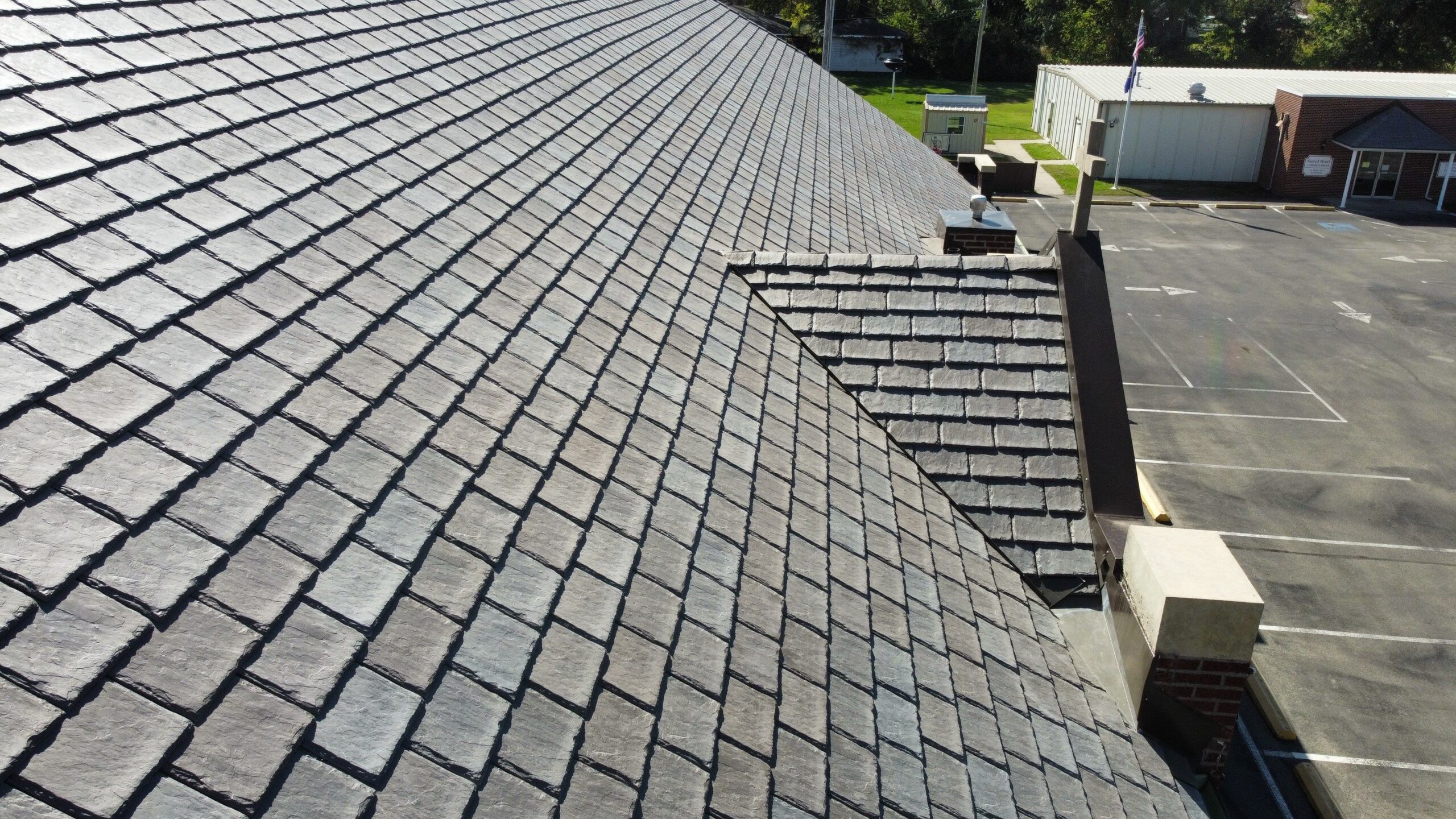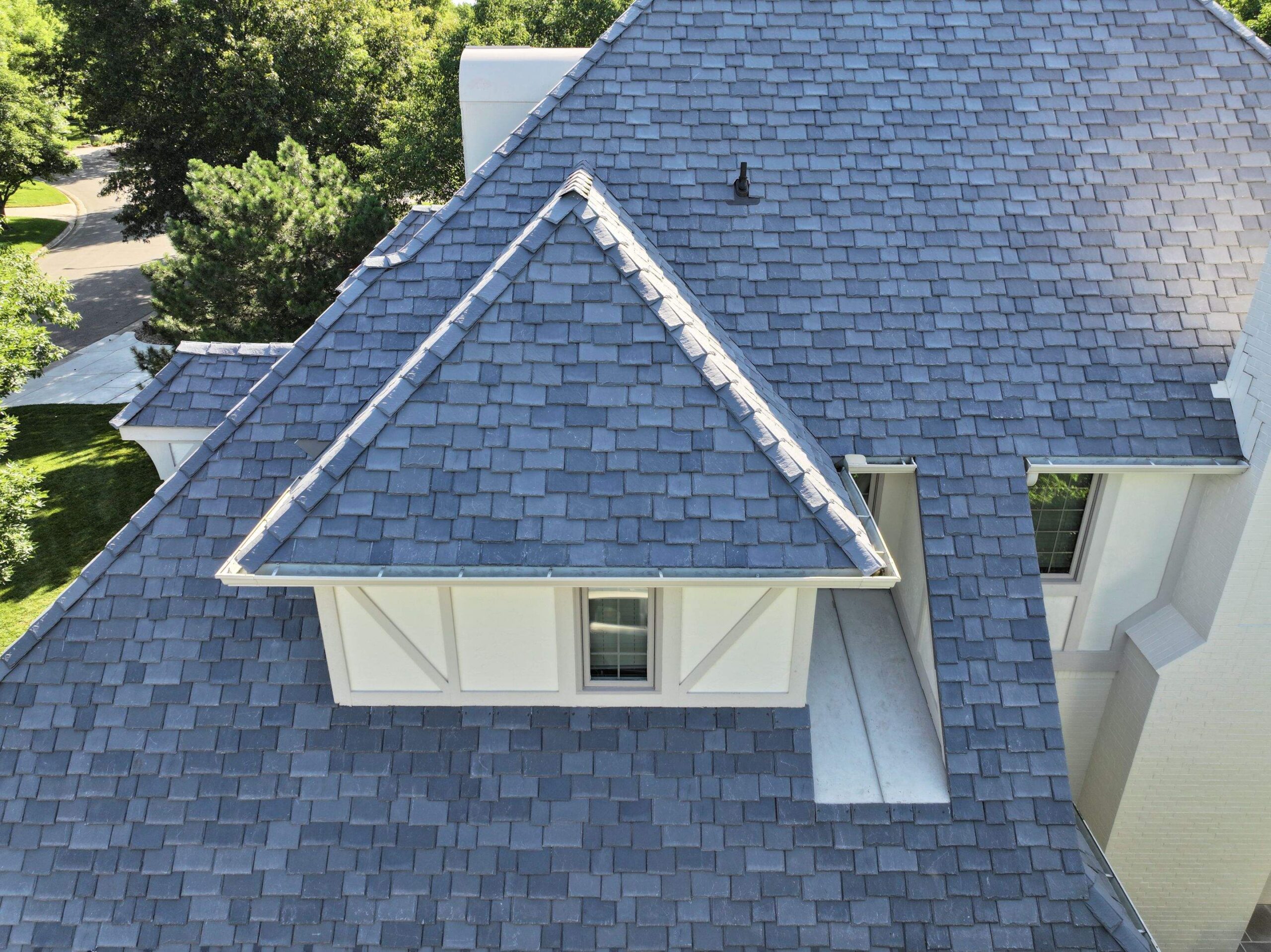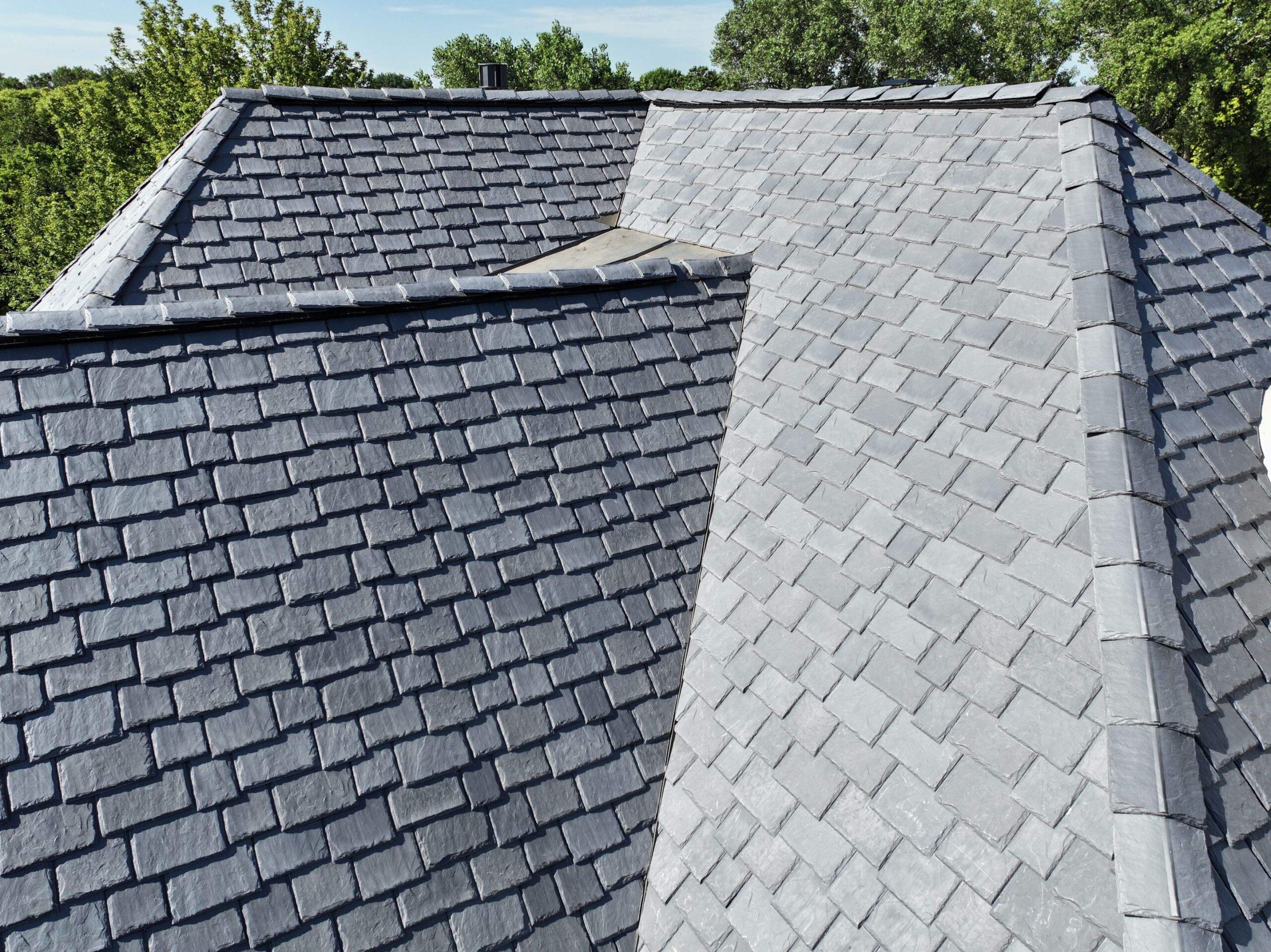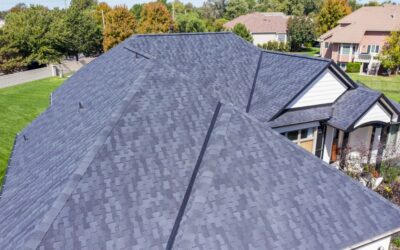Cedar shake has been a trusted roofing material in America for centuries, dating back to the 17th century when European settlers began using the abundant natural resources around them. Wood shake shingles are traditionally made through a hand-splitting and/or sawing process, using high-quality logs With its rustic charm, durability, and availability, cedar quickly became a popular choice for homes across the growing colonies. While cedar shake remains admired for its beauty and character, its popularity has declined in modern times due to its maintenance demands and vulnerability to weather, algae, and fire. In response, synthetic cedar shake was developed, offering the same timeless look with enhanced durability, improved fire resistance, and greater protection against wind and algae.
History
Synthetic roofing has come a long way, and its roots go deeper than many homeowners might expect. As early as the 1840s, roof coverings were being created from felt or woven fabric coated in pine tar and sand. These early systems were designed to improve weather resistance and set the stage for one of the most significant roofing innovations in history.
In 1903, Henry Reynolds introduced the first asphalt shingles, revolutionizing the roofing industry. By 1904, these shingles began to gain widespread popularity due to their increased durability and superior fire resistance compared to traditional wood shakes. Asphalt shingles remain one of the most common roofing materials in America today, seen on homes across neighborhoods nationwide.
But the innovation didn’t stop there. In the late 20th century, manufacturers began experimenting with composite materials, particularly plastics, in an effort to replicate the look of natural cedar shakes or slate tiles, without the drawbacks. These early synthetic shingles offered a lighter, more durable, and weather-resistant alternative to wood, and eliminated many of the fire risks associated with natural materials.
Today’s Modern Synthetic Shingles
Today’s synthetic roofing materials are engineered with precision. Made from high-performance materials like virgin polyethylene, polypropylene, or recycled plastics, these products are designed to withstand the toughest elements—impact, UV exposure, algae, wind, and freeze-thaw cycles.
Leading manufacturers such as DaVinci, Brava, CertainTeed, and GAF produce synthetic roofs built to last 30–50 years or more. They combine aesthetics with advanced protection, offering homeowners peace of mind without sacrificing curb appeal.
Let’s take DaVinci, for example. Their synthetic shakes are crafted from a proprietary blend of virgin polyethylene, UV and thermal stabilizers, and specialized fire retardants. During production, raw resin pellets are infused with colorants and additives, then molded using high-tech compounding extruders and injection systems. This process results in shingles that closely resemble the look and texture of real cedar, right down to the subtle variations in color.
Rigorous quality control ensures every shingle meets industry standards for impact resistance, wind performance, and UV durability. Unlike natural wood, DaVinci synthetic shakes won’t fade, split, curl, or warp. They’re also Class A fire-rated and built to withstand high winds and extreme weather, making them an ideal option for both beauty and long-term protection.
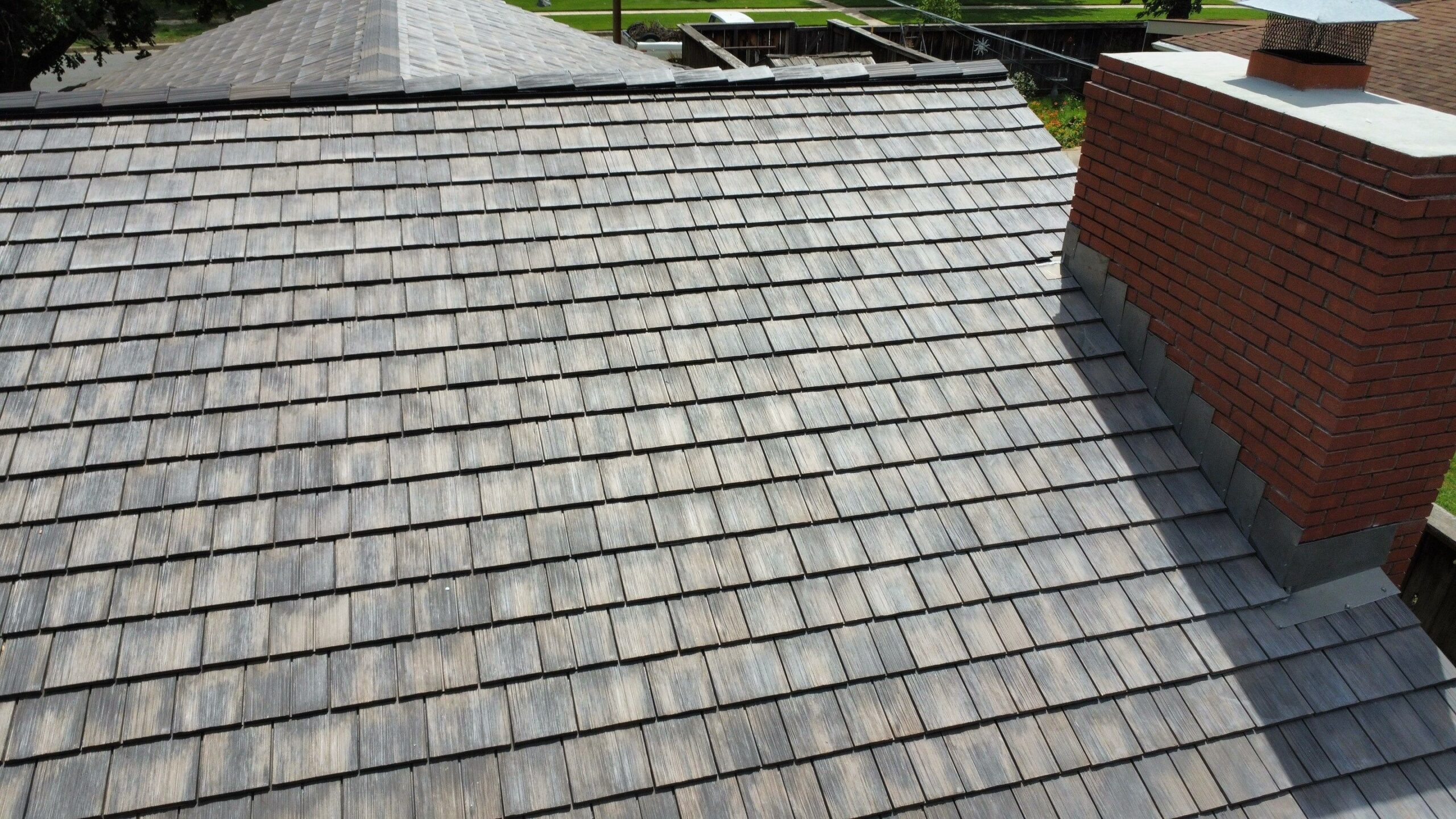
Roofing Reinvented
It’s incredible to see how far synthetic roofing has evolved, from early tar-and-fiber composites to asphalt and asbestos-cement, and now to today’s advanced polymer blends. What started as a practical solution has grown into a high-performance roofing option that blends cutting-edge technology with timeless style. If you’re considering upgrading from traditional cedar shakes or exploring long-lasting alternatives to asphalt, modern synthetic shingles could be the perfect fit.
Cost
There’s no way around it, installing a new roof is a significant investment. The total cost can vary greatly depending on the materials you choose. Both natural cedar and synthetic shake roofs fall into the premium category and represent a larger upfront investment than standard roofing options. While synthetic roofing tends to be more affordable than natural cedar, both will cost more than even the highest-end asphalt shingle roof. It’s also important to note that insuring a natural cedar roof typically costs more due to its higher fire risk. For homeowners seeking a high-end, long-lasting, and visually striking roof, either option can be a great choice, but they are not considered standard or budget-friendly solutions. It is hard to give an exact number because so many factors go into a roofing project.

Pictured above is a stunning new wood shake roof that adds timeless charm and character to the home. While the color will naturally weather and change over time, it will only enhance the roof’s rustic beauty.
Pros and Cons of Cedar Shake
Pros
Timeless Curb Appeal
Cedar shake roofs are celebrated for their natural beauty and timeless charm. Their rich texture and warm tones complement a wide range of architectural styles—from rustic cottages to elegant estates. Each shake is unique, adding character and depth to the roofline that many homeowners find irresistible. Over time, cedar gracefully weathers to a soft silvery-gray, enhancing its classic appeal and proving that true beauty only gets better with age.
Natural Insulation Benefits
One of the standout advantages of wood shake roofing is its excellent natural insulation. When properly installed, cedar shakes help regulate indoor temperatures by keeping your home cooler in the summer and warmer in the winter. This added thermal efficiency can lead to noticeable energy savings over time, helping to reduce heating and cooling costs while enhancing overall comfort year-round.
Durability in Extreme Weather
Cedar shake roofs are built to perform in tough conditions. Made from dense, high-quality wood, they provide excellent resistance against high winds, heavy rain, hail, and other severe weather events. Their natural strength helps maintain the structural integrity of the roof over time, even under significant stress. The thickness of each shake also acts as a durable shield against falling debris and physical impact, making cedar a reliable choice for long-term protection.
Cons
Fire Risks
While cedar shake roofs offer timeless beauty and natural charm, they do come with some drawbacks, chief among them is their vulnerability to fire. Even though many cedar shakes are treated with fire-resistant chemicals, they’re still not the best choice for homes in wildfire-prone areas. If you live in a region where fire risk is high, it’s worth considering alternative roofing materials that offer the same aesthetic without the added danger.
Algae and Moss Growth
Cedar roofs are especially vulnerable to moss and algae, which thrive in damp, shaded environments. While the green streaks and patches may be an eyesore, the real concern is the damage they can cause. Moss holds moisture against the wood, accelerating rot, decay, and overall deterioration, especially during the winter months when trapped moisture can freeze and expand. Over time, this significantly shortens the lifespan of the roof. Regular cleaning and maintenance are essential to prevent growth and preserve the integrity of a cedar shake roof.
Splitting and Cracking
As a cedar roof ages, it begins to lose its natural flexibility and impact resistance, making it more prone to splitting and cracking. These signs of wear not only diminish the roof’s appearance but can also compromise its ability to protect your home from the elements. If left unaddressed, these issues can lead to leaks and further structural damage. For this reason, it’s recommended that homeowners consider replacing cedar shake roofs before they reach the very end of their lifespan.
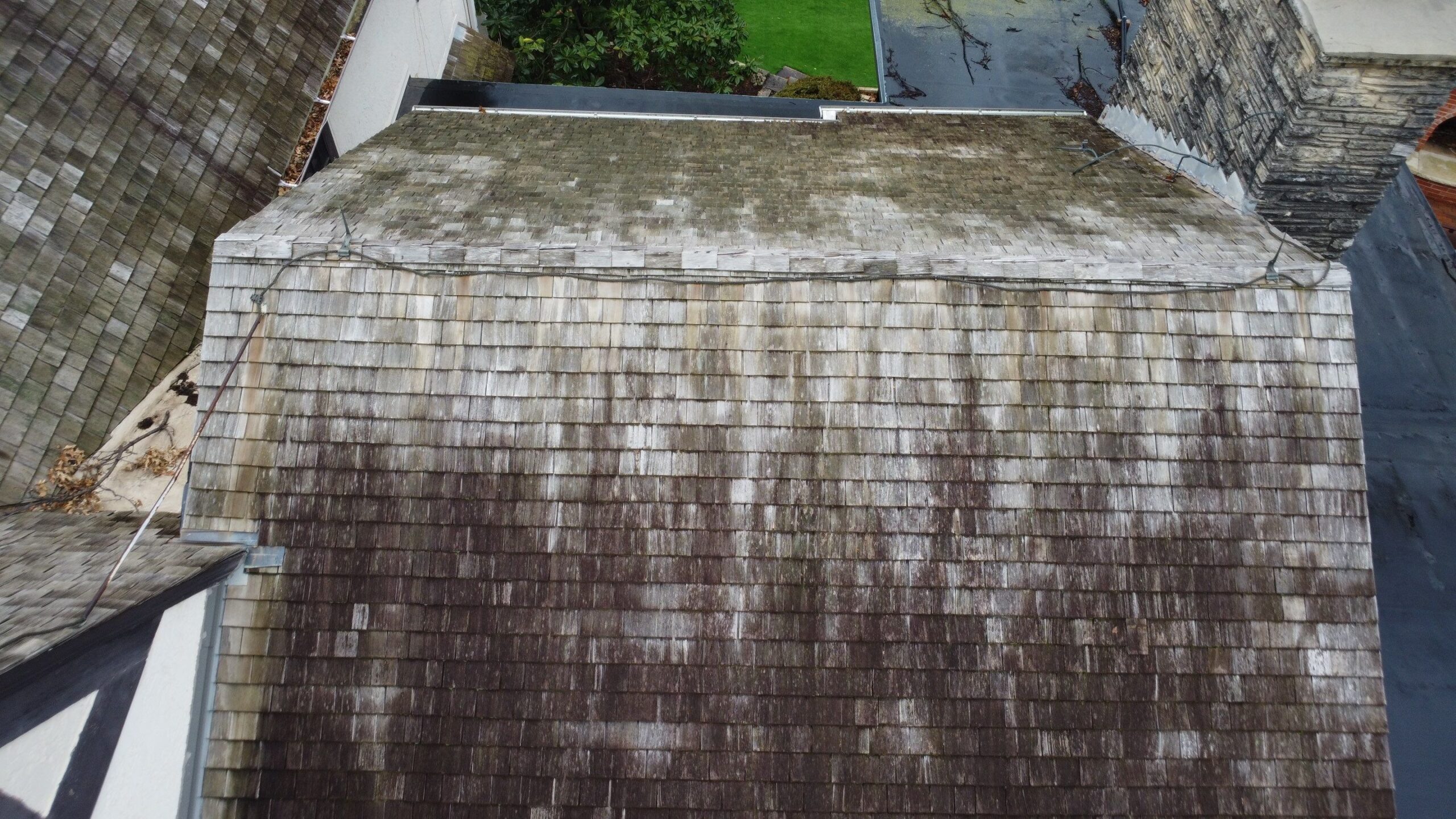
This image highlights some of the common signs that a wood shake roof is nearing the end of its lifespan—cracking, algae growth, and noticeable discoloration. These issues not only affect the roof’s appearance but also signal underlying wear that can compromise its performance.
Pros and Cons of Synthetic Shake
Pros
Sustainability at the Forefront
As environmental concerns continue to shape industries across the globe, roofing is no exception. Manufacturers are now designing materials that not only perform well but also minimize environmental impact. One major advantage of composite shingles is their sustainable composition. Many are made from recycled plastics and rubber, reducing landfill waste and giving new life to old materials.
Boosted Curb Appeal
Composite shingles are an excellent way to elevate your home’s curb appeal. Designed to replicate the look of natural materials like wood shake, slate, or tile, they offer the same high-end aesthetic—without the maintenance or vulnerabilities of the real thing. With their realistic textures and rich colors, composite shingles deliver timeless beauty that lasts.
Exceptional Durability and Longevity
Composite shingles offer the authentic look of natural materials, like wood shake or slate, without the common drawbacks those materials bring. Engineered from advanced polymers, plastics, and rubber, these shingles are designed to endure even the harshest weather conditions. Their flexible composition helps absorb impact instead of cracking or breaking, which is why most composite shingles carry a Class 4 impact rating, the highest available. Unlike natural wood shakes, composite shingles resist fading over time, maintaining their color and appearance for decades. When properly installed, a composite roof can provide 40 to 50 years of reliable, low-maintenance performance, making it a smart, long-term investment for any homeowner.
Cons
Not a Natural Roofing Material
While synthetic wood shakes are expertly crafted to replicate the appearance of natural cedar, they are still a man-made product. Advanced manufacturing techniques allow for impressive texture, color variation, and grain patterns—but achieving a 100% authentic, natural look is nearly impossible. For homeowners seeking the raw, organic charm that only real wood provides, synthetic options may fall just short in comparison, despite their many practical advantages.
More Expensive Than Traditional Roofing Materials
While synthetic wood shakes are typically more affordable than natural cedar, they do come at a higher price point than traditional roofing options like asphalt shingles. This upfront cost may be a drawback for some homeowners working with a tight budget. However, the investment can pay off in the long run—thanks to the enhanced curb appeal, superior durability, and minimal maintenance synthetic materials offer. For those looking for a balance between aesthetics and long-term value, synthetic shakes are a strong contender.
Installation Complexity
Installing synthetic wood shakes is a specialized process that demands experience and expertise. Unlike more straightforward roofing materials such as asphalt shingles, synthetic shakes require precise techniques to ensure proper alignment, secure fastening, and effective weatherproofing. Because of this, installation can take longer and often involves higher labor costs. Choosing a qualified roofing professional familiar with synthetic materials is essential to guarantee a durable, visually appealing roof that performs as expected.
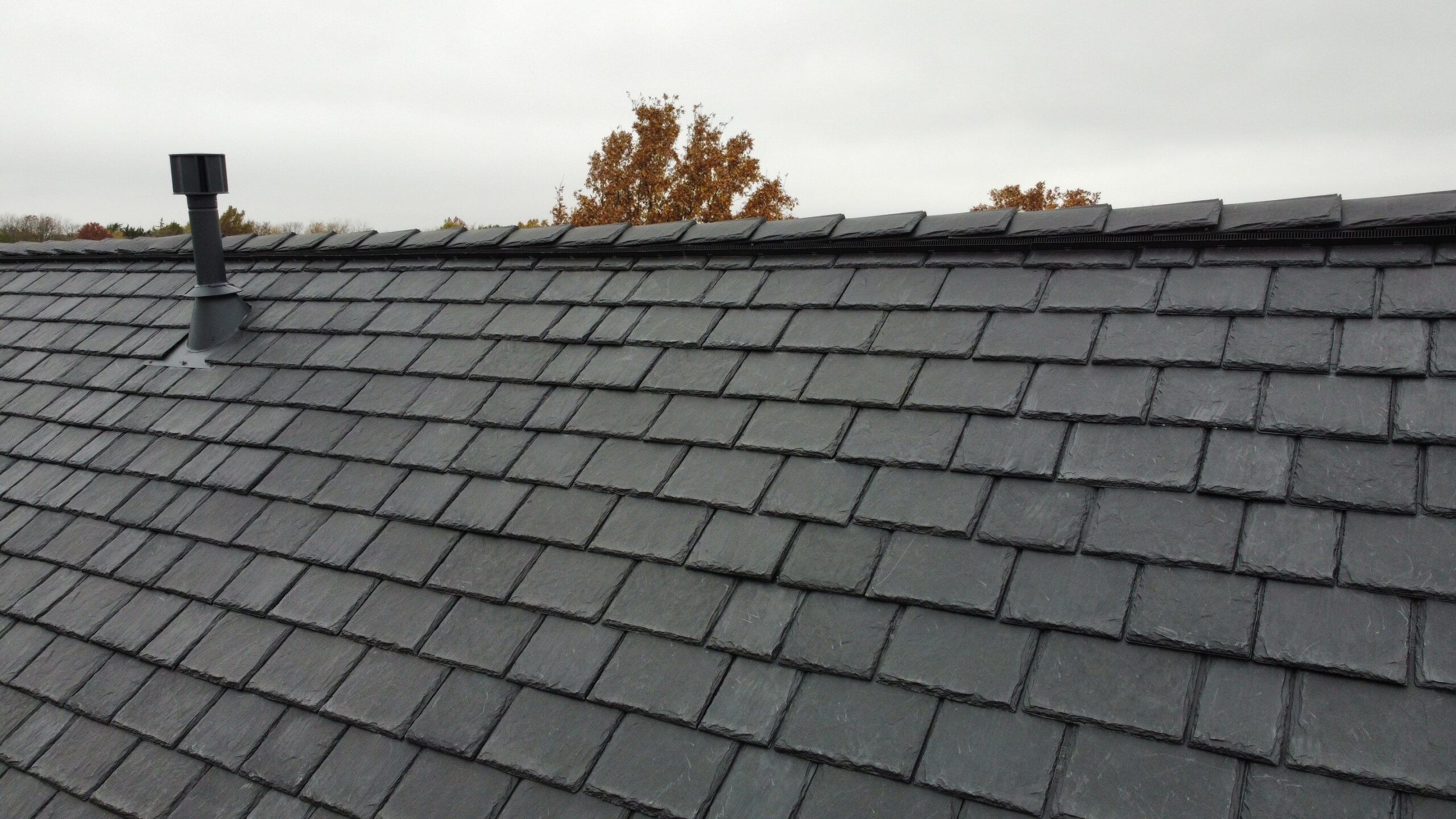
This roof is a synthetic material designed to replicate the look of natural slate. Its color complements the home’s exterior beautifully, tying in the black accents for a cohesive and polished appearance.
Choosing the right roofing material is a significant decision that affects your home’s appearance, performance, and long-term value. Both cedar shake and synthetic shake roofing offer unique advantages, from the natural beauty and charm of real wood to the advanced durability and low maintenance of modern composites. While cedar shakes bring a timeless, rustic aesthetic and natural insulation benefits, they also require more upkeep and carry greater risks, especially in harsh climates. On the other hand, synthetic shakes provide an impressive combination of style and strength, replicating the look of cedar without its vulnerabilities. Ultimately, the best choice depends on your budget, lifestyle, aesthetic preferences, and climate considerations. Whether you’re drawn to the authenticity of natural wood or the innovation of synthetic materials, both options deliver beauty and character that can elevate your home for decades to come.
